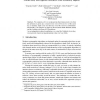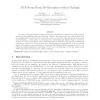TCC
2010
Springer
15 years 5 months ago
2010
Springer
Aumann and Lindell defined security against covert attacks, where the adversary is malicious, but is only caught cheating with a certain probability, where the idea is that in man...
TCC
2010
Springer
15 years 5 months ago
2010
Springer
We construct public-key cryptosystems that remain secure even when the adversary is given any computationally uninvertible function of the secret key as auxiliary input (even one t...
TCC
2010
Springer
15 years 5 months ago
2010
Springer
Goldreich-Krawczyk (Siam J of Comp’96) showed that only languages in BPP have constant-round public-coin black-box zero-knowledge protocols. We extend their lower bound to “ful...
TCC
2010
Springer
15 years 5 months ago
2010
Springer
Learning is a task that generalizes many of the analyses that are applied to collections of data, and in particular, collections of sensitive individual information. Hence, it is n...
TCC
2010
Springer
15 years 5 months ago
2010
Springer
A family of trapdoor functions is one-way under correlated inputs if no efficient adversary can invert it even when given the value of the function on multiple correlated inputs. T...
TCC
2010
Springer
15 years 5 months ago
2010
Springer
The search of efficient constructions of ideal secret sharing schemes for families of nonthreshold access structures that may have useful applications has attracted a lot of atten...
TCC
2010
Springer
15 years 5 months ago
2010
Springer
Abstract. We consider weakly-verifiable puzzles which are challengeresponse puzzles such that the responder may not be able to verify for itself whether it answered the challenge ...
0
posts
with
0
views
0
views
 Homepage
Homepage Concurrent Computing | Cryptography | CUDA | Directx Compute | Formal Methods | OpenCL | Parallel Computing | Parallelism | Security | Simulation | Sonar | Visualisation |
PKC
2009
Springer
15 years 9 months ago
2009
Springer
ded abstract of this paper appears in PKC 2009, S. Jarecki, G. Tsudik (Eds.), volume 5443 of LNCS, pp. 357-376, Sringer-Verlag, 2009. CCA-Secure Proxy Re-Encryption without Pairing...
PKC
2009
Springer
15 years 9 months ago
2009
Springer
We address the problem of polynomial time factoring RSA moduli N1 = p1q1 with the help of an oracle. As opposed to other approaches that require an oracle that explicitly outputs b...







